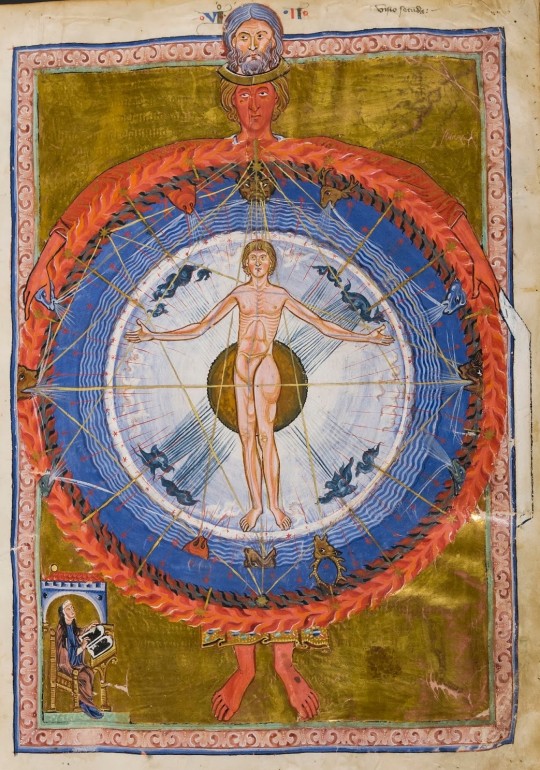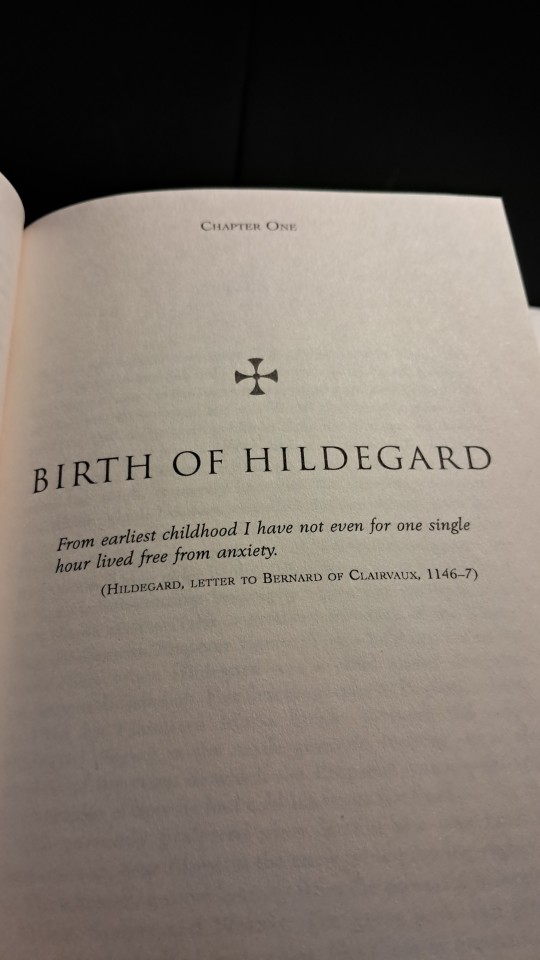#hildegard of bingen
Text

hildegard's vision of the universal man and the cosmic spheres
in an illuminated transcription of hildegard of bingen's "book of divine works" ("liber divinorum operum"), italy, mid-13th century
source: Lucca, Biblioteca Statale di Lucca, MS 1942, fol. 9r
#13th century#hildegard of bingen#hildegard von bingen#liber divinorum operum#the book of divine works#medieval art#medieval cosmology#illuminated manuscript
709 notes
·
View notes
Text
I am a person who has neither the strength nor the pride of a lion. I am soft like a fragile rib, but I have been filled with a secret inspiration.
Hildegard von Bingen, Hildegard Von Bingen’s Mystical Visions : Translated from Scivias, translated by Bruce Hozeski.
172 notes
·
View notes
Text
The soul is kissed by God in its innermost regions. With interior yearning, grace and blessing are bestowed. It is a yearning to take on God’s gentle yoke, It is a yearning to give one’s self to God’s Way.
Hildegard of Bingen
211 notes
·
View notes
Text

St Hildegard von Bingen
oil on carved wood, 2019
9″ x 27″ x .75″ Alex Naszados
#catholic art#oil on carved wood#medieval#wood#hildegard of bingen#Abbess#benedictine#mystic#Alex Naszados#art
102 notes
·
View notes
Text

242 notes
·
View notes
Text

Hildegard of Bingen
67 notes
·
View notes
Text


Hildegard is in charge of handing Easter eggs for this Easter parade. She feels uncomfortable not wearing her nun garment, but she can't help but notice how cute she looks in this Easter dress.
Hildegard of Bingen
#happy easter#easter#hildegard of bingen#hildegard#historical#nun#moe history#lussid#magic school lussid#sid story#history#cute#cards#funny#moe#anime
65 notes
·
View notes
Quote
We cannot live in a world that is interpreted for us by others. An interpreted world is not a hope. Part of the terror is to take back our own listening. To use our own voice. To see our own light.
Hildegard of Bingen
#Hildegard of Bingen#quotelr#World# Hope# Light# Parting# back# interpretation# interpreter# lighting# listening# living# other# part# terror# terrorism# use# voice#quotes#literature#life quotes#author quotes#prose#lit#spilled ink#writers on tumblr#writing inspiration#poets on tumblr
14 notes
·
View notes
Text
2023 OCTOBER 04 Wednesday
"[We] should go forward resolutely, without carrying the guilt of [the] past, so as not to defy God but rather to be secure without self-pity or blaming [our] past sins."
~ St Hildegard of Bingen, Le Scivias
#bible#gospel#further reading#saint#Hildegard of Bingen#go forward resolutely#guilt of the past#past sins#defy#secure#God#Lord#Jesus#Christ
8 notes
·
View notes
Text
You can now download the medieval nun's fake alphabet as a font I just made from the web archive :)
"https://archive.org/details/hildegard-of-bingen-font"
it might also appear on 1001fonts.com if they approve it, but I'm way too lazy to check up on that.
To install the font, just download one of the files, open it, it'll have a little pop up that previews the font for you, then just click install.
Then you should be able to use it next time you open a program that accesses fonts, if your computer is old it might take a while to load it fully.
It's kinda small compared to other fonts, so if you know how to edit fonts, feel free to fix that! It's public domain, so you can use it for literally anything you want. Literally anything. "Can I use it for--" YES. Anything!!! Want to use it as a quick easy fantasy language for that book or game you're making??? do it!!!
Here's a preview with the Hildegard of Bingen font bolded.

[ID: Black text that reads first in English, "Here's a preview!", and then followed by the symbol font Hildegard of Bingen, which uses fake symbols in place of the usual letters. End ID.]
If you want to leave a tip, my cashapp, venmo, and paypal are all "Rjalker", with the same icon of a flower I have here :)
#free stuff#free fonts#public domain fonts#fake alphabets#fake alphabet#free alphabet#Hildegard of Bingen
8 notes
·
View notes
Text
Welcoming Hildegard in Heaven

Some of my favorite stories about St. Hildegard von Bingen are about the friendships she had. First was Jutta von Sponheim (left), who taught Hildegard to read and write and probably to sing and play music too. When she passed away, Hildegard succeeded her as abbess of Disibodenberg. Second was monk Volmar (second from left), who encouraged Hildegard in her moments of doubt; his death was especially heartbreaking for Hildegard. Like Jutta and Hildegard, Richardis von Stade (right) was from a noble family and stayed in Disibodenberg and later Rupertsberg under Hildegard. Against Hildegard's wishes, Richardis became an abbess in a separate abbey. Her unexpected death shortly after leaving Rupertsberg broke Hildegard's heart. I could just imagine how happy their reunion in Heaven must have been in September 17, 1179.
#holy friendships#hildegard of bingen#hildegard von bingen#volmar#jutta von sponheim#richardis von stade#benedictine#aeshna's art
9 notes
·
View notes
Text
They do not consider whether I am salty or not salty, sweet or bitter, a dweller of heaven or of earth. What does this mean? They do not pay attention to either the spice or the sweetness of the Scriptures.
Hildegard von Bingen, Hildegard Von Bingen's Mystical Visions : Translated from Scivias, translated by Bruce Hozeski.
15 notes
·
View notes
Text
Angels, living light most glorious!
Beneath the Godhead in burning desire
in the darkness and mystery of creation
you look on the eye of your God
never taking your fill:
What glorious pleasures take shape within you!
Hildegard of Bingen, "O gloriosissimi"
4 notes
·
View notes
Link
Hildegard of Bingen (German: Hildegard von Bingen; Latin: Hildegardis Bingensis; c. 1098 – 17 September 1179), also known as Saint Hildegard and the Sibyl of the Rhine, was a German Benedictine abbess and polymath active as a writer, composer, philosopher, mystic, visionary, and as a medical writer and practitioner during the High Middle Ages.[1][2] She is one of the best-known composers of sacred monophony, as well as the most recorded in modern history.[3] She has been considered by scholars to be the founder of scientific natural history in Germany.[4]
Hildegard's convent elected her as magistra (mother superior) in 1136. She founded the monasteries of Rupertsberg in 1150 and Eibingen in 1165. Hildegard wrote theological, botanical, and medicinal works,[5] as well as letters, hymns, and antiphons for the liturgy.[2] She wrote poems, and supervised miniature illuminations in the Rupertsberg manuscript of her first work, Scivias.[6] There are more surviving chants by Hildegard than by any other composer from the entire Middle Ages, and she is one of the few known composers to have written both the music and the words.[7] One of her works, the Ordo Virtutum, is an early example of liturgical drama and arguably the oldest surviving morality play.[a] She is noted for the invention of a constructed language known as Lingua Ignota.
Although the history of her formal canonization is complicated, regional calendars of the Roman Catholic church have listed her as a saint for centuries. On 10 May 2012, Pope Benedict XVI extended the liturgical cult of Hildegard to the entire Catholic Church in a process known as "equivalent canonization". On 7 October 2012, he named her a Doctor of the Church, in recognition of "her holiness of life and the originality of her teaching."[8]
#Hildegard of Bingen#wikipedia#history#middle ages#medieval europe#Medieval women#medieval#Medieval history#women in art history#women in history#women writers#article#polymath
21 notes
·
View notes
Text

Hildegard of Bingen, "Universal Man" illumination from Hildegard's Liber Divinorum Operum, 1165
Hildegard of Bingen (German: Hildegard von Bingen, pronounced [ˈhɪldəɡaʁt fɔn ˈbɪŋən]; Latin: Hildegardis Bingensis; c. 1098 – 17 September 1179), also known as Saint Hildegard and the Sibyl of the Rhine, was a German Benedictine abbess and polymath active as a writer, composer, philosopher, mystic, visionary, and as a medical writer and practitioner during the High Middle Ages. She is one of the best-known composers of sacred monophony, as well as the most recorded in modern history. She has been considered by scholars to be the founder of scientific natural history in Germany. Via Wikipedia
#HildegardofBingen #UniversalMan #DivinorumOperum #artherstory #artbywomen #womensart #palianshow
8 notes
·
View notes
